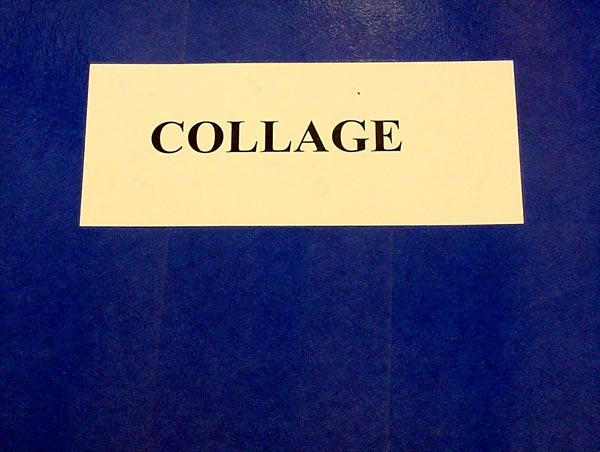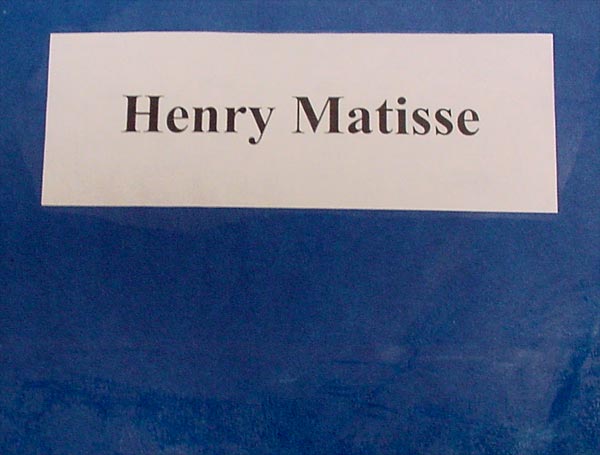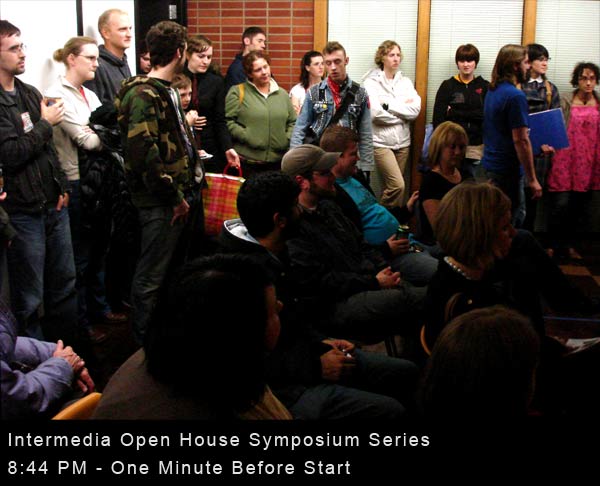 This document charts the proceedings of the Fall 2007 Intermedia Open House Symposium Series, a collection of discourse surrounding the "in-between spaces" of creative practice. The Symposium Series--comprising of five separate symposiums--took place during the Fall 2007 Intermedia Open House at the Communications Center on campus of The University of Iowa, Friday, October 26th.
This document charts the proceedings of the Fall 2007 Intermedia Open House Symposium Series, a collection of discourse surrounding the "in-between spaces" of creative practice. The Symposium Series--comprising of five separate symposiums--took place during the Fall 2007 Intermedia Open House at the Communications Center on campus of The University of Iowa, Friday, October 26th.
The navigational links to the left display the title of each symposium; clicking will display more information about each session.
At Intermedia (The University of Iowa)--a conceptual art program with roots in Dada and Fluxus--participants engage in a wide variety of creative practice. The modes of expression include, but are not limited to, installation, performance, videos, presentations, and other 4-Dimensional environments. With seven presenters from diverse backgrounds, the Symposium Series presentations were strong in discourse while rooted by Intermedia's Fluxus and Dada traditions.
ThoughtMesh (the publication system of this Website) is an implementation of "semantic web" publication, where relationships between online content and ideas are linked in dynamic ways. With the possibilities of ThoughtMesh wide-ranging, I am pleased to present the proceedings of "The Fall 2007 Intermedia Open House Symposium Series" in this environment. The tags above link to the sections of this document, but also many other documents on the Web by clicking the 'lexias out' tab.
ThoughtMesh is featured in the current issue of USC's Vectors Journal. For more information about ThoughtMesh please visit the journal's ThoughtMesh project page at:
http://www.vectorsjournal.org/index.php?page=7&projectId=84
Also, forums are provided to discuss the project or specific uses, at:
http://www.vectorsjournal.org/forums/index.php?viewId=356
Very special thanks to Jon Winet (Intermedia Area Head) for contributing many of the documentation photographs dispersed throughout this document.
"Living as 4 in a Jackson 5 macro-culture: the sub-moronic anal projection of everyday synaesthetic culture buy and fore a universal marketplace or parleying utopia; planting the pseudo-metaphorical seeds of the reconstituted, asymmetrical, human condition for complicated junkets of naturalistic, narcissistic, sweet pork barrel politics in the 22nd century."
Symposium scheduled: 8:45 - 9:00 PM
Invited speakers: K Crain & Cole Zrostlik
Born on a farm in rural Alabama, K fought his way out of poverty and into the arms of sweet success as an Intermedia BFA at The University of Iowa. A professional body-building-hair-growing-state-champion-art-crafter, K hopes to subtly obtain MFA degrees from various institutions while continuing to inspire youths of the Americas to brush, and floss, twice daily.
After realizing adulthood in the third grade, Cole decided that life could, in fact, wholly become a performance. Now in, like, her fifth year of college, Cole has regressed, responsibility- and maturity-wise, a bit from an earlier time and is now pursuing a BFA in Intermedia, specializing in pretty, shiny things. Like any other typical girl, Cole prides herself on her outrageous collections of lipsticks, hotel keys, dirty movies, men, and Martha Stewart publications.
Editors Introduction
Cole Zrostlik and K Crain began the Symposium Series with a multi-media explosion that set the tone for the rest of the sessions, and to a large extent Intermedia Open House. Their project proposal was a video. Their project presentation was a 4-dimensional barrage of light, sound, and movement, taking the form of the aforementioned video projected on the symposium screen, K on roller skates, and read excerpts of a 550 page document. The session questioned the relationship of viewer to video and artwork to current events.
However, the most memorable moment of the 13 minute session came during a plate toss between Cole and K: twenty ceramic plates thrown across the presentation stage then ritually dropped to the floor, shattering. Smartly, the demonstration was not about the sounds and sights of smashing--as I originally thought--but rather, the sweeping up of the broken fragments amidst the chaos of the rest during the last 5 minutes.
This session provides an abundance of media. Along-side a single-channel video, the speakers present the contents of Information Overload, a 6.25 Megabyte online research document/blog that, when printed out on paper, constitutes 550 pages. 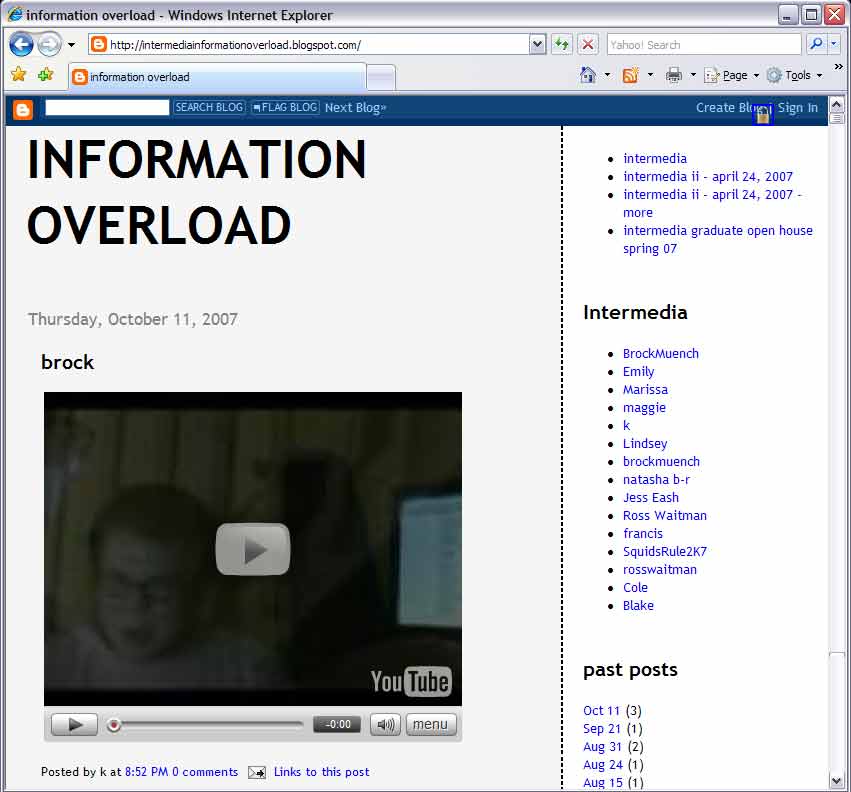
"Recent News
The term "blog" is a portmanteau, or, in other words, a blend of the words web and log (Web log). "Blog" can also be used as a verb, meaning to maintain or add content to a blog. In November 2006, blog search engine Technorati was tracking more than 57 million blogs. -Posted by k"
Information Overload is available in its entirety at http://intermediainformationoverload.blogspot.com
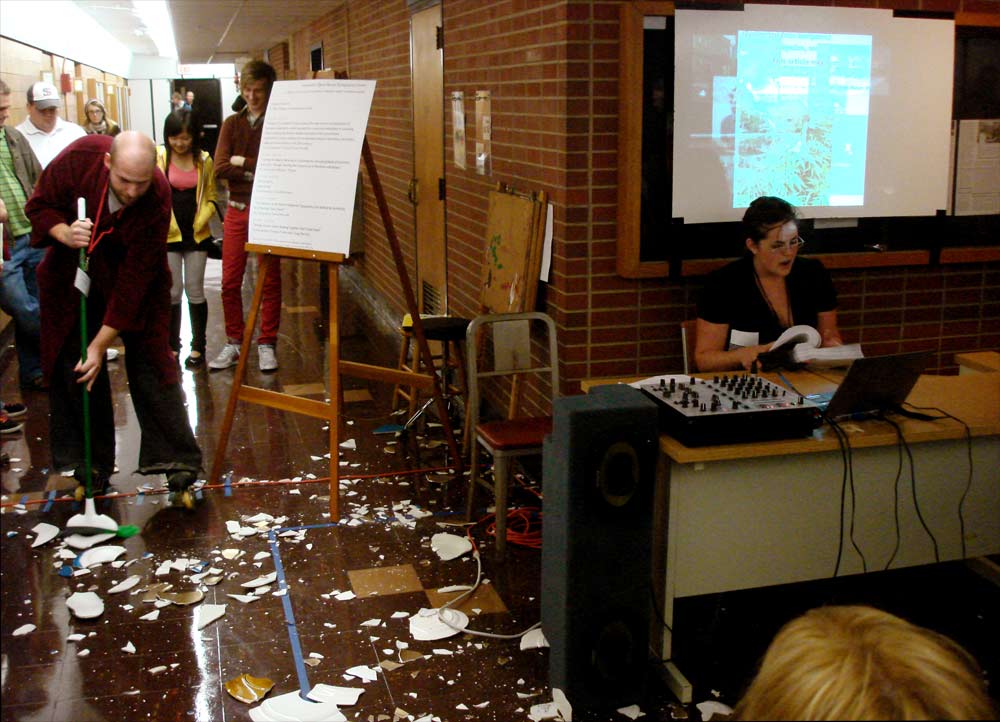
Attention then turns to 20 ceramic plates, broken on the linoleum floor.
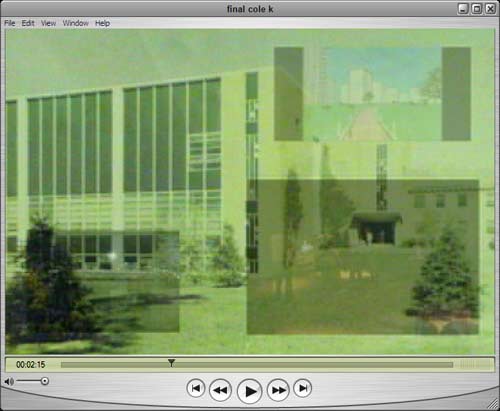
And, a multi-dimensional video (playing on the screen and acted out).
Available at:
http://intermedia3...final_cole_k.mov
"Learning the Didactic Meaning of Translating the Conceptual Mode of Geometric Abstraction, Through Teaching the Comparisons of Mondrian and Matisse."
Symposium scheduled: 9:00 - 9:15 PM
Invited speaker: Matthew Wagner
Matt is earning his teaching licensure in Art Education and is student teaching in West Liberty, Iowa. He is from the West side of Iowa City, but has enjoyed living all 'round yonder, West Coast and East Coast. Those designs he makes kinda look like geometric abstraction, so he used what he knew for some inspiration and found discoveries teaching Mondrian and Matisse to youth. And Matt is truly a trooper, but please, for this symposium session, (play along/humor him and) call him Mr. Wagner.
Editor's Introduction
Expanding the definitions of "symposium," Matt proposed to "teach" the Symposium Series attendees his provocative elementary school lesson plan on two legendary art figures, Henri Matisse and Piet Mondrian. Symposium Series aside, I am extremely impressed by Matt's ability and desire to teach the work of these two creators in Modern Art. Mondrian's non-representational paintings and Matisse's impressionistic style are difficult for even the most educated; Matt's delivery to elementary students, presented for us at the Symposium, wrapped complex ideas with simple points of entry that left the audience with a strong sense of understanding and desire to further explore the subjects.
Below is Matt's lesson plan. Required in education, the document outlines the goals, technical skills, and specific activities for this unit.
Matthew J. Wagner
Comparing and Contrasting
Matisse and Mondrian
1st Grade
Goal:
Students will compare and contrast elements found in both Henri Matisse's work and Piet Mondrian's work. Children will identify shapes and colors as important design elements in a collage. Students will create a collage with a concentration on cutting and pasting. This will help them increase their skills with materials and the use of shape in expressing ideas in their artwork. Students will develop their recognition and identification of basic shapes. This will help students increase their discrimination of basic shapes found in complex structures, as well as help student's verbal skills for discussing the use of shape in artworks.
Collage, Shape, Line (straight, squiggle), Space, Color, Balance and Symmetry.
Balance: Harmony of design and proportion. Symmetry: Equal in size and value.
National Standards/Student Objectives:
Students will learn to make collages and use it to explore the Big Idea of comparing and contrasting space, color, balance and symmetry found in the work of Matisse and Mondrian. (1,3)
Students will learn a brief history about Matisse and Mondrian and their perception of space, color, shape, balance, and symmetry. (4,5)
Students will gain background knowledge into the various materials and methods artists have employed in collage work. (4)
Interdisciplinary Connections/Contextual Frame of Reference:
A discussion of the definition of collage will take place. Collage: a form of art in which various materials such as photographs and pieces of paper or fabric are arranged and stuck to a backing. In French it means, "gluing". Students will draw from their own knowledge and what they learn about Matisse and Mondrian, about Space, Color, Shape, Balance, and Symmetry to develop their own collage.
Preparation:
I will need to create my own example of the work I want them to create: a collage.
I will need to make large copies of images by Matisse and Mondrian. I will need to reserve books for reference about the history of Matisse and Mondrian's life, books with images of their work, and children's books to read to the students as an introduction or end to the class activity.
Student Input:
Students will be able to explore the idea of collage through comparing and contrasting the works of Matisse and Mondrian and the student's own work. They will explore the relationship between artist and environment.
Basic design, pattern, composition, and hand-eye coordination skills will be employed to collage, while cutting out, arranging, and pasting materials onto a background.
Materials & Costs (Dick Blick/Staples):
Stainless Scissors, 5", pointed: $1.61 ea. X's 25 = $40.25
50 lb. 18" x 24" Paper, Package of 100 Sheets: $16.57
White Glue Gallon: $10.79 ea.
Colored Paper, 24"X36", Assorted colors, 50 sheets, $25.92
Markers, 200 assorted colors, $64.99
Crayons:
Black: $1.68 per 12 pack
White: $1.60 per 12 pack
Jumbo paper clips: $1.19/100
Total Cost: $162.99
Inappropriate and dangerous use of scissors will be the most significant safety hazard. A hazardous situation may be limited by keeping track of the utensils.
Attention:
To challenge the students who have a better understanding or are familiar with the material I will call on them to add their "expert" knowledge to share with the class. I will also have them assist other students if they are completed with their work early. I will also provide appropriate reading material and images about the artist for further understanding. I will assist students who work slower than the rest and will help them with cutting and pasting materials upon request.
Lesson Procedure:
Activity Overview:
Students will cut out shapes from colored paper and paste them onto a flat background in the style of Mondrian then compare to the work of Matisse and create another collage in his style.
1. Students will create a collage influenced by Mondrian then Matisse.
2. Cut out 3 shapes, small, medium and large squares or rectangles, out of blue, red, and yellow paper (Mondrian).
3. Place shapes on paper and glue down.
4. Take 5 black strips of paper and arrange in a balanced/symmetrical fashion, criss-cross, up and down, across paper (Mondrian).
5. Glue down black strips.
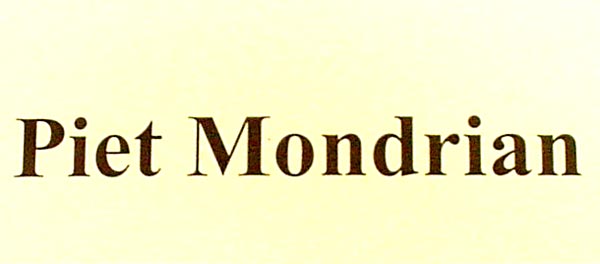 6. Cut off black strips that go over the edge of the paper.
6. Cut off black strips that go over the edge of the paper.
7. Arrange extra black strips on the inside edges of the colored shapes.
8. Glue black strips.
9. Compare the Mondrian style collage with the Matisse style examples.
10. Cut 4-6 squares or rectangles out of any color the student chooses.
11. Fold 3 in half and cut out a leaf-like shape.
12. Arrange nicely and glue down the squares of paper including the paper that leaves were cut out of.
13. Arrange nicely and glue down leaf shapes.
14. Take 3 black strips of paper and either cut into small pieces or leave long.
15. Arrange nicely and glue down black pieces and strips of colored paper.
Editor's Note: Wagner's less plan segues to a description of each day's activities. During the Intermedia Open House Symposium Series, Wagner presented Day 1. Please see below the description of this day:
Students will arrive in class and be seated on the carpet. Students will be introduced to the artist Mondrian and his artwork through looking at images and talking about the elements of design. The instructor will ask the class to raise their hand if they have heard of the artist and choose quiet students to explain to the class what they know. Students then will be given a brief history of the artist's philosophy about his own work.
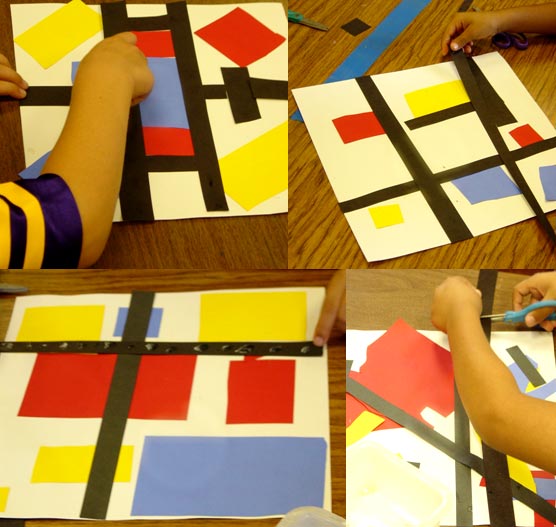 Essential Motivational Questions:
Essential Motivational Questions:
What is a collage? What is balance? What is balance on the playground (hands out to look like balancing)? Try and sound out this name/word. Does anyone have a friend named Pete? Pete had many artist friends such as Pablo Picasso. Does anyone know what a landscape is? Does anyone know what it means to subtract (take away)? What do you see in this collage? What colors do you see? What are the shapes called (rectangle, square)? How many sides do these shapes have? What size are they (small, medium, and large)? What do the black lines look like? (Picture a city from above, buildings, streets, railroads, and cars) What does overlapping mean?
(Content Standard 4, understanding the visual arts in relation to history/cultures)
(Content Standard 5, reflecting upon and assessing the characteristics and merits of their work and the work of others).
Students will be introduced to the artwork of Mondrian through looking at images produced by the artist. Students will go over vocabulary words as they look at these images and try to pick out these words to describe what they see in the work of the artist. Ask students to look at the images and explain using their own words what they think the images show and mean and describe the shapes they see.
(Content Standard 3, choosing/evaluating a range of subject matter, symbols, ideas).
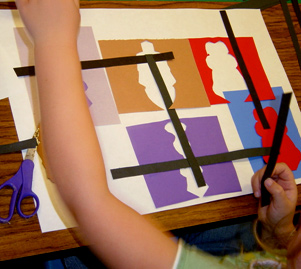 The instructor will explain, with the image, examples of what a collage is.
The instructor will explain, with the image, examples of what a collage is.
Students will be introduced to materials for their collage construction. Instructor will describe the collage activity and introduce the content and subject matter of the collage. Instructor will remind the students to put their names and class abbreviation on the back of their work. Focus should be put on the explanation and demonstration and steps that show efficient ways to cut and paste (safety tips: While being careful with scissors turn the paper while the student cuts curves, use glue sparingly, a damp paper towel to keep the student's fingers clean).
1. Students will create a collage influenced by Mondrian then Matisse.
2. Cut out 3 shapes, small, medium and large squares or rectangles, out of blue, red, and yellow paper (Mondrian).
3. Place shapes on paper using balance (may overlap) and glue down.
(Content Standard 2, using knowledge of structures and functions).
Students will be dismissed to their tables. They will use scissors to cut out their shapes, then and arrange and glue the colored paper shapes to their white paper.
(Content Standard 1, understanding and applying media, techniques, processes).
Clean up procedures. Instructor will hand out and then collect each student's envelop of scraps and shapes. With time left students will be instructed on how to properly clean up their table and the room. Students will follow clean up procedures properly and quietly so they may be chosen to line up at the door.
Editor's Note: We very much appreciate Matt Wagner's wonderful contribution. For the following days (continuing after the text above), or the complete document from the author, please see MattWagner-Matisse-Mondrian.pdf.
"Becoming Un:
Unbecoming"
Symposium scheduled: 9:15 - 9:30 PM
Invited speaker: Katie McGowan
Katie McGowan is an Intermedia student who is fixated with characterization. In order to better understand the people and concepts that she studies, she attempts to become them.
Editor's Introduction
The Symposium Series continued (now to its 30th minute) with a practice-based presentation by Katie McGowan. Her talk may be framed by this companion: 1-1/2 weeks after the Symposium Series event, Katie presented at Intermedia Talks, a series of "job talk" presentations by Intermedia graduate students and friends to the School of Art & Art History community. During this talk--about Katie's on-site investigations of plastic-surgery clinics in Los Angeles--I suddenly became aware that the artwork she was describing was not about plastic surgery. Rather, her artwork was about the artist Katie McGowan not being informed enough about plastic surgery to make the work she wanted to make, and setting out on a 3 year journey. The production of artwork that occurred during this time was ancillary and packed with embedded value. The self-effacing, reflexive practice in which Katie works was on view during the Symposium Series when she changed from all-black, tight clothing, to a vintage woman's outfit that didn't quite fit between the 50s and 2007.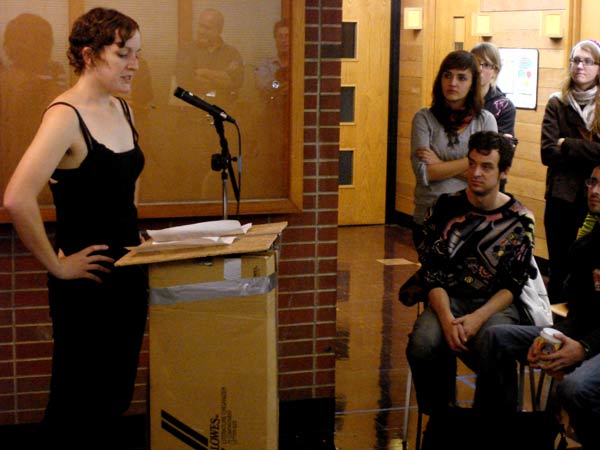 Good evening, ladies and gentlemen. Thank you for attending the Intermedia Open House Symposium—Also, thanks to my colleague Craig Dietrich for devising and facilitating this evening's proceedings.
Good evening, ladies and gentlemen. Thank you for attending the Intermedia Open House Symposium—Also, thanks to my colleague Craig Dietrich for devising and facilitating this evening's proceedings.
Librarian by day-dominatrix by night, a southern belle on the prowl, a bull dyke boxing fan or an uber-femme milquetoast...
How we become who we become...
What makes us who we are ... and how experience mediates the already established persona, are themes that continually flow through my thought process.
The practice of transforming from character to character can be a problematic endeavor. One could probably make the case that in striving to become someone else we lose a piece of our selves. I acknowledge this but embrace it as an experience fraught with opportunities to grow.
[Begin removing costume— remove tie, button up shirt]
The mutability of the subject position is a primary point of departure for much of my work. I believe this is a worthy investigation for one who feels compelled to create art, write and think about the mythic "Other".
[Continue removing costume-- pants, shoes, and mess up hair] 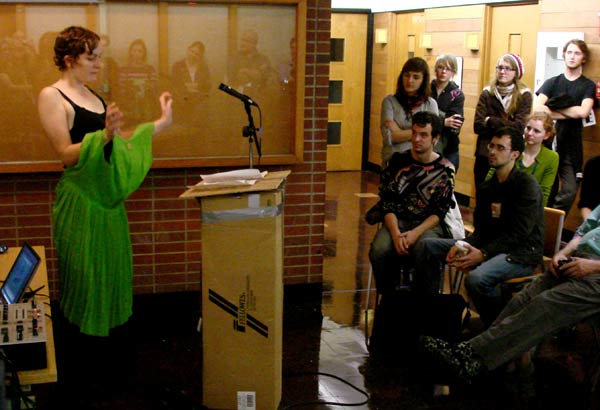 Stanislavski's 'system', Strasberg's Method, pretending to be a foul-mouthed biker chic, and writing character profiles are all tools for becoming such unbecoming characters. The specific method in "The Method" refers to the practice of actors drawing upon their own experiences, reactions and emotions to influence their portrayals of specific characters.
Stanislavski's 'system', Strasberg's Method, pretending to be a foul-mouthed biker chic, and writing character profiles are all tools for becoming such unbecoming characters. The specific method in "The Method" refers to the practice of actors drawing upon their own experiences, reactions and emotions to influence their portrayals of specific characters.
[Begin changing into costume 2—put on necklace, dress]
I am not an actor but for my purposes, these exercises help me understand how people think. My fascination is partly rooted in the desire to understand people and ideologies that I don't agree with. If I become a creature that I would otherwise deem vulgar or unpleasant, I may then become more sympathetic.
[Shoes, hair]
Stephanie: "Soooo, like guys, I am totally into playing dress up!"
-----CLAP------
Mom: "Katie does these strange projects where she dresses up like different characters and goes out to talk to people and write about them." 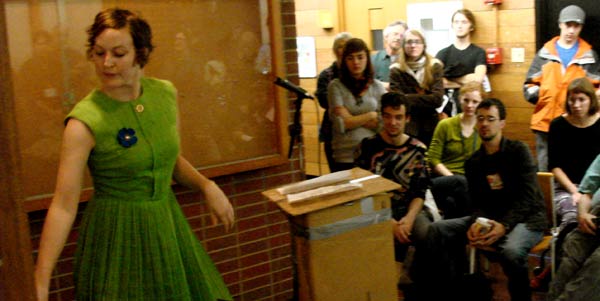 -----CLAP------
-----CLAP------
Brother: "My sister is insane. She puts on these costumes and then puts herself in really weird, sometimes dangerous places ... It's really screwed up. I guess then she makes some kind of 'art' projects about it. One day she's gonna get killed"
[Lipstick—finishing touch--deliberate]
So, whether it's a simple costume change or a lifestyle change, I endorse becoming no one.
Rather than being, I strive to become.
Thank you.
"The Emptiness at the Heart of Modernist Typography: Can Nothing Be Something, Or Is There No There There?"
Symposium scheduled: 9:30 - 9:45 PM
Invited speaker: David Herwaldt
To support his life as an artist and "privatgelehrter" (what the Germans call an independent scholar), David Herwaldt has toiled at odd jobs, working as a short order cook, an assembler of aluminum-mesh air filters, a corn castrater, and a blues dee-jay, to list just a handful of his numerous occupations. He enjoyed a very brief stint as a guitarist in a cruise ship band. In his role as photographer, he once had to yell at Roger Clemens to get his cooperation for a group portrait and was once dressed down by Justice Sandra Day O'Connor for taking too many pictures.
Editor's Introduction
David presents a capsule account of the development of modernist typography, concentrating on its active use of the space between printed objects, the "negative space", the so-called "white space", or "ground." While his talk limits itself to twentieth-century typography, his discussion of the significance of "charged voids" lends itself to analysis of many modes of Time-Based Media and may be useful in understanding the breaks between comic strip panels, say, or the nanosecond-long separations between movie frames.
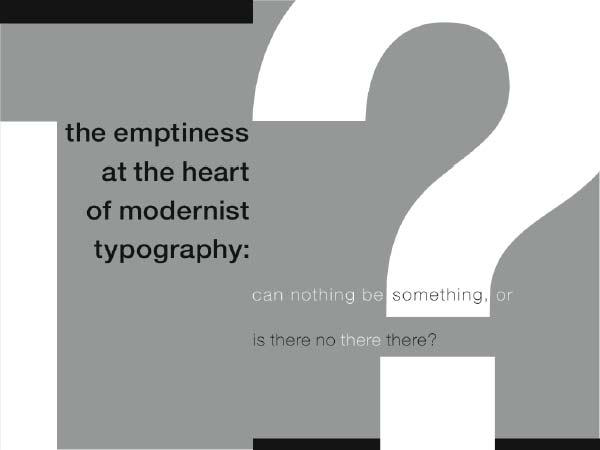 To begin, I should say that by modernist typography
To begin, I should say that by modernist typographyI mean the typography that developed
in Western Europe following World War One
and later led to Swiss graphic design.
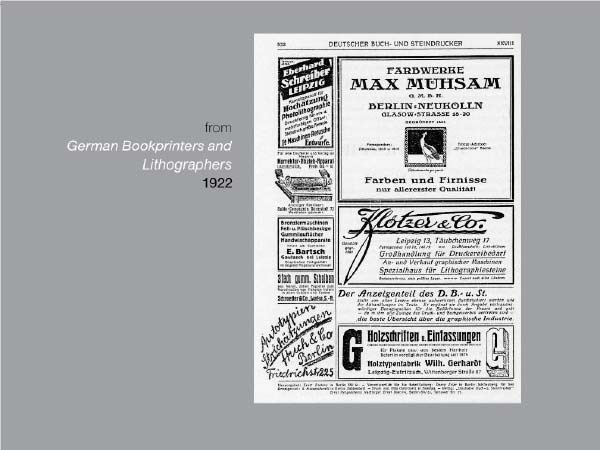 From 1922, a sample of the typography
From 1922, a sample of the typographythe modernists were designing against.
It suffers from a bad case of what the Germans
call "platz angst": the fear of empty space.
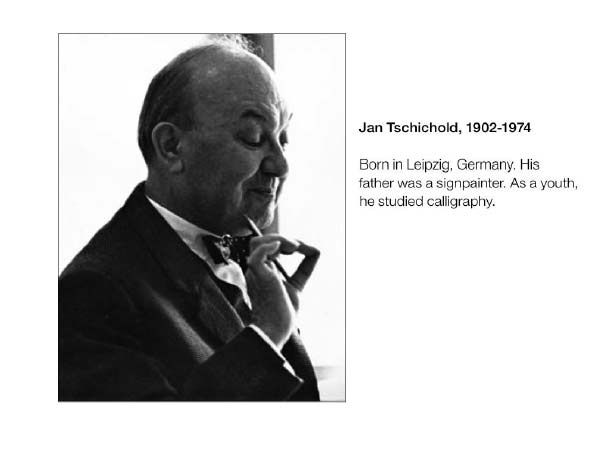 In his 1928 book Die Neue Typographie,
In his 1928 book Die Neue Typographie,Jan Tschichold codified the the new style.
Today, I'll concentrate on one point of the new dogma:
the importance of contrast.
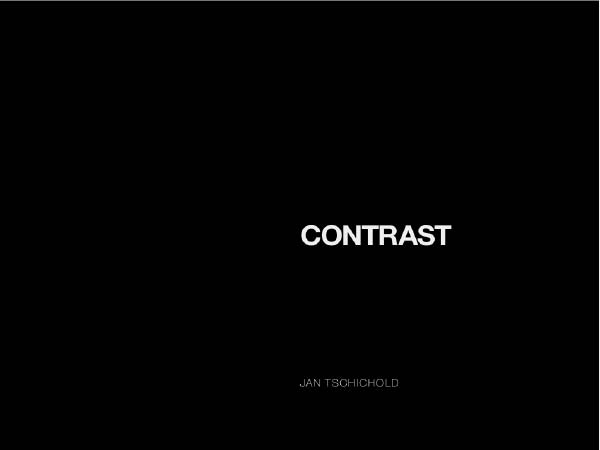 Tschichold famously said:
Tschichold famously said:Contrast is perhaps the most important
element in all modern design.
But contrast is necessary
for any design. Perhaps he meant that
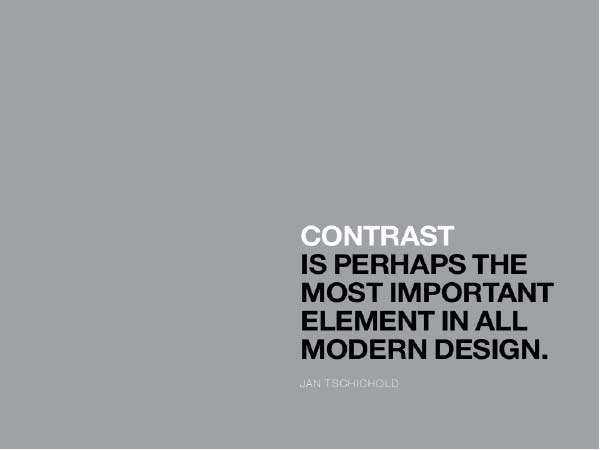 contrast is more important now than before.
contrast is more important now than before.Or that new modes of contrast are
at work now. Here you see contrasting
tones, sizes, and forms,
but also the contrast of fullness and emptiness.
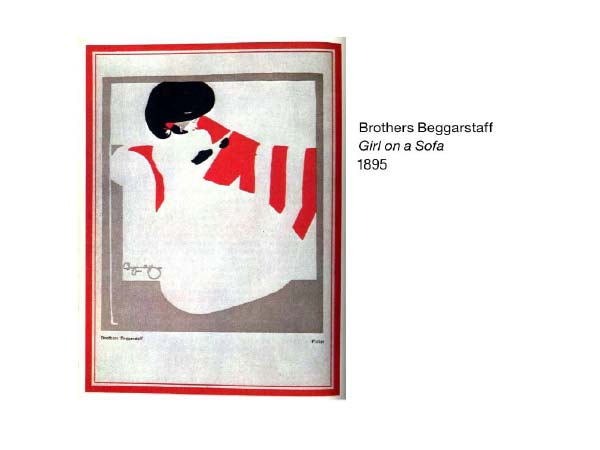 Poster designers employed this new mode of contrast
Poster designers employed this new mode of contrastbefore typographers did.
Here the Brothers Beggarstaff--who were not brothers--
used nothing but blank paper
to indicate a woman's form.
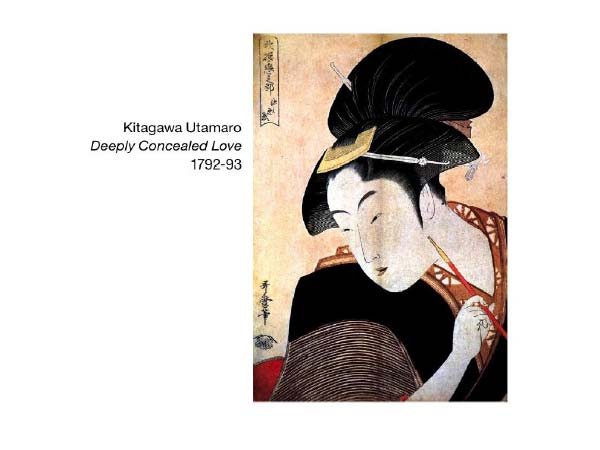 They, and other late 19th century poster designers,
They, and other late 19th century poster designers,learned from Japanese printmakers, how nothing
could be something.
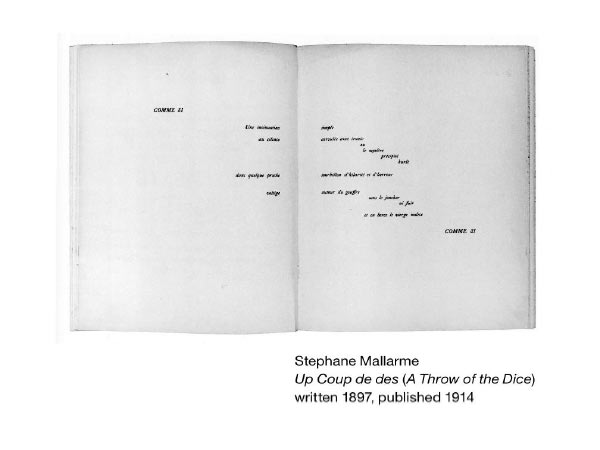 Stephane Mallarme, a poet, not a typographer,
Stephane Mallarme, a poet, not a typographer,was likely the first to bring this innovation into typography.
His poem is to be looked at as much as it is to be read.
His spaces signify just as the words do.
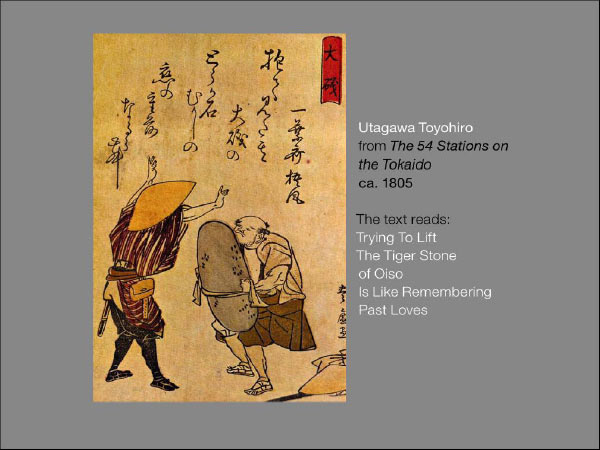 Mallarme was deeply influenced by Japonisme,
Mallarme was deeply influenced by Japonisme,the late 19th century craze for Japanese artifacts.
Japanese prints likely taught Mallarme that words
are images before they are words.
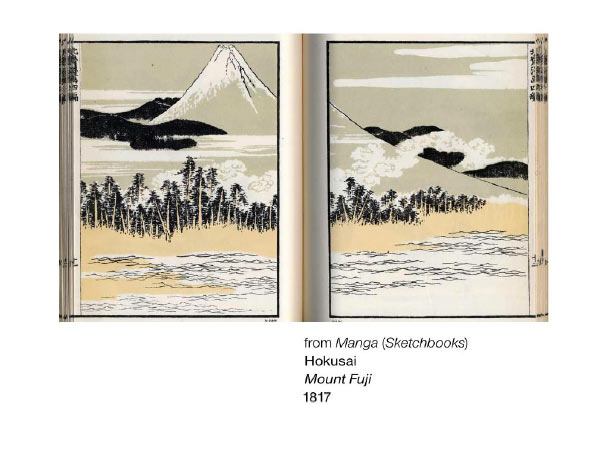 Perhaps Hokusai's Sketchbooks taught him
Perhaps Hokusai's Sketchbooks taught himthat the gutter separating pages is not incidental
but can be an active element in a composition.
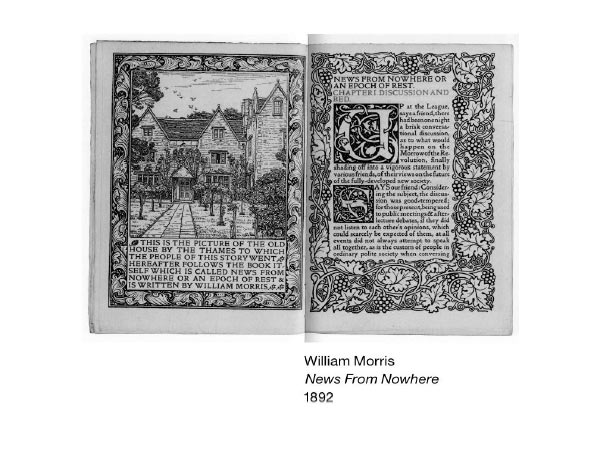 By way of contrast, here is William Morris'
By way of contrast, here is William Morris'News from Nowhere, in which
there is no nowhere and the designer pretends
the gutter isn't there.
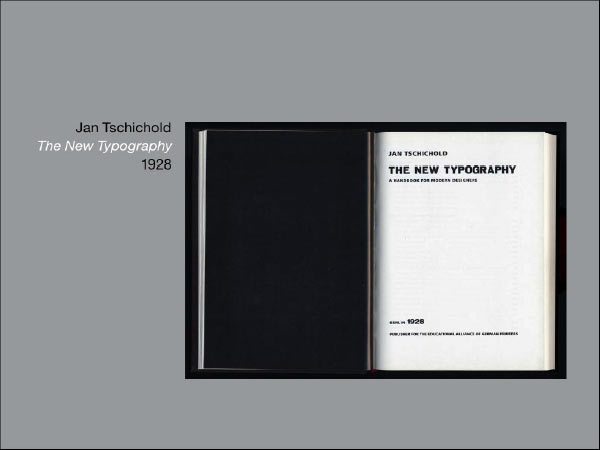 The title spread of The New Typography
The title spread of The New Typographyin its look announces the new style:
no extraneous decoration, the type itself
is treated as a formal element, space is an active presence.
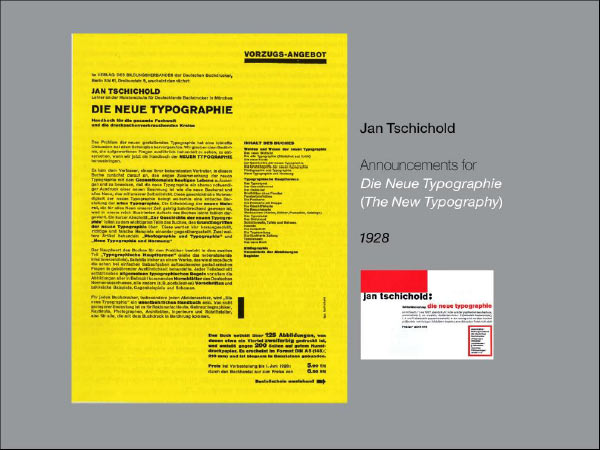 Publicity for the new book
Publicity for the new bookdisplays the important influence of
Theo van Doesburg and Mondrian,
of De Stijl, on Tschichold.
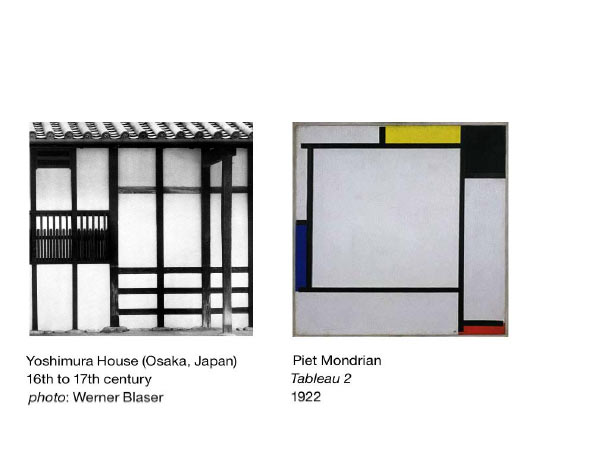 Behind De Stijl, there was Frank Lloyd Wright;
Behind De Stijl, there was Frank Lloyd Wright;behind Wright, there was Japanese art and
architecture, embodying the principles of
asymmetry, modularity, and open but charged space.
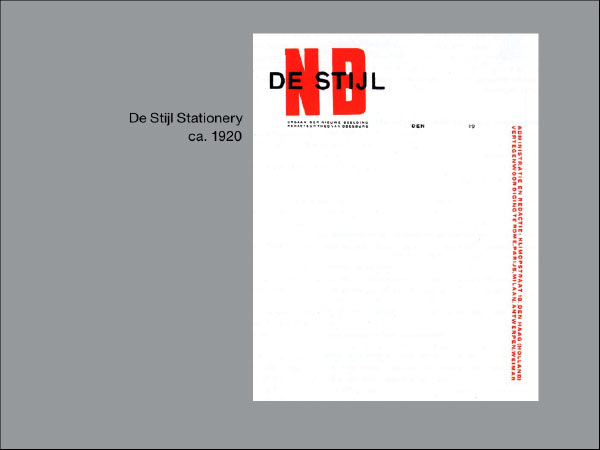 The De Stijl letterhead uses empty space
The De Stijl letterhead uses empty spaceso wonderfully that it must have seemed
almost sacriligious to use it for correspondence.
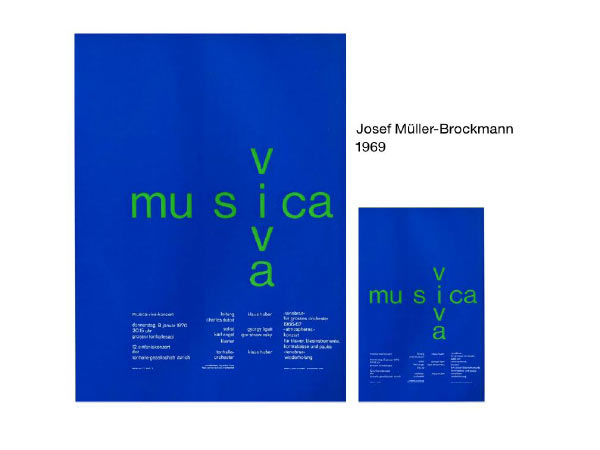 From 1969, a poster by the Swiss designer
From 1969, a poster by the Swiss designerJosef Muller-Brockmann. Compare his design to the smaller,
cropped version to see how enlivening empty
space can be.
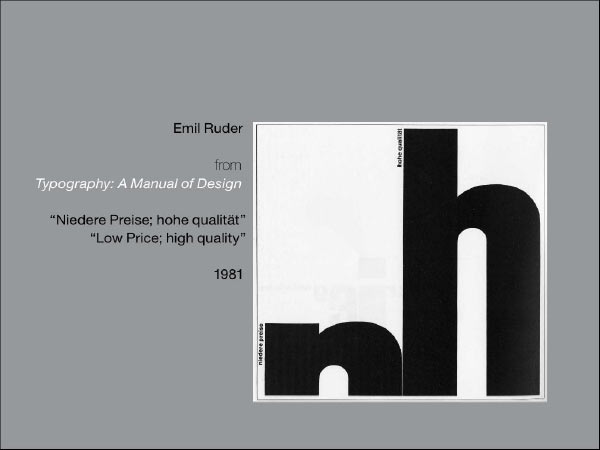 This mundane commercial design from
This mundane commercial design fromEmil Ruder's book Typography perfectly illustrates
the eleventh aphorism of Lao-Tse:
From clay, pots are made,
but it is the emptiness inside them that makes
the essence of the pot.
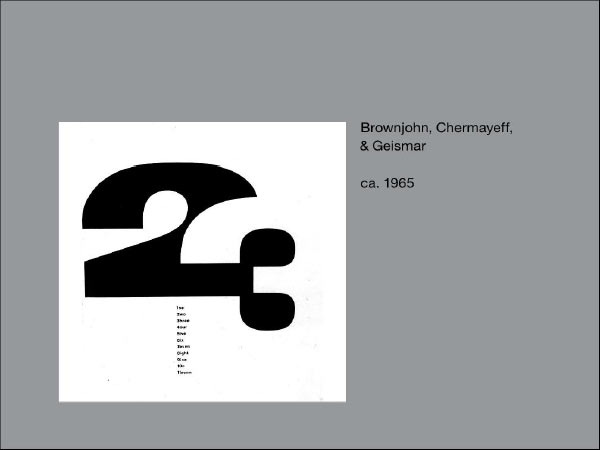 Indeed, nothing can be something.
Indeed, nothing can be something.Here nothing is not zero, but three.
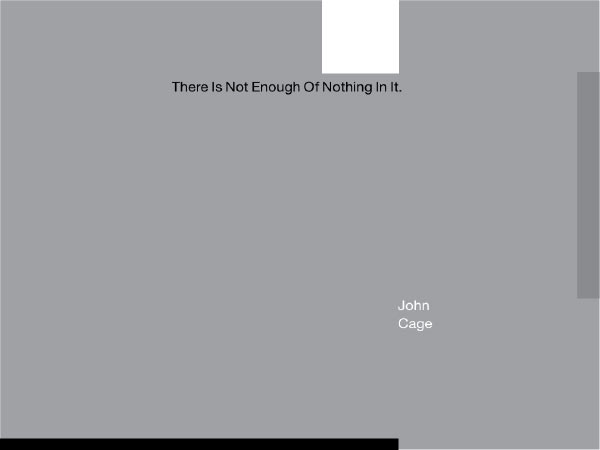 My presentation today contradicts itself.
My presentation today contradicts itself.Speaking of nothing, I have given you
much of something,
and none of nothing.
I will stop now.
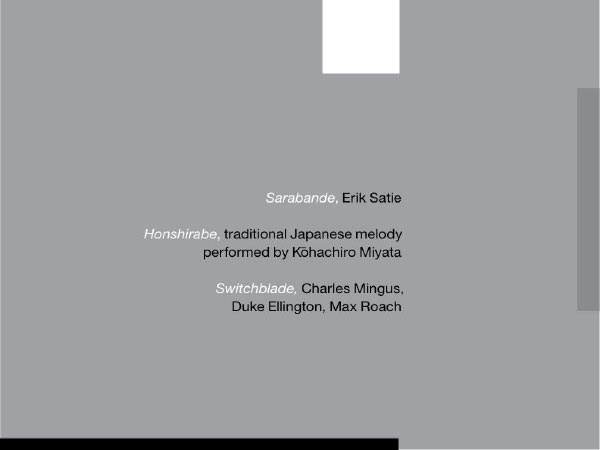 Credits
Credits"Striking Distance: When Working Together, Don't Look Down"
Symposium scheduled: 9:45 - 10:00 PM
Invited speaker: Vanessa Vobis with Craig Dietrich
Vanessa Vobis is a multimedia artist currently pursuing her MFA. She immigrated from Germany to California in the mid-nineties and recently returned to Europe for a several week long research trip through Germany, Croatia, and Italy. Please visit http://www.vanessavobis.com for notes and ponderings.
Craig Dietrich is a new media artist and researcher who, along with exploring new modes of scholarship with USC's Vectors Journal, is a MFA candidate in Intermedia at The University of Iowa. Craig is presently in production of "USA Today," a media project investigating trans-nationalism's consequences on American activity. For more please visit http://www.craigdietrich.com.
Editor's Introduction
Here we find ourselves at the fifth and final symposium of the Intermedia Open House Symposium Series. Starting in a 4-dimensional labyrinth, we have journeyed to pedagogy, then performance and identity, to typography... and now? A history of the Universe... what else! Vanessa provides an intriguing glimpse of a timeline that results in the creation of art by one MFA candidate and graduate instructor in the School of Art & Art History. All timelines are inherently prejudiced, but this presentation takes note and advantage, traveling into the minds-eye.
Not being the best at introducing oneself, after Vanessa I present a parallel view of the Universe, intersecting timelines around a good art making object (the digi-cam). Cheers!
4.6 Billion years ago, the Earth cooled from it's volcanic state after the formation of the Solar System.
In the beginning of earth's history, the planet was a an ocean of intense heat and magma. As collisions subsided the earth began to cool, forming a thin crust on its surface. As the cooling continued, water vapor escaped and condensed in the atmosphere. Clouds formed and storms reigned cooling the surface further until the earth was flooded and formed the seas. The ecosystem was born.
Scientiests are still trying to unravel one of earth's greatest enigmas: When did life first appear and how did it happen? It is estimated that the first life forms on earth were basic, one-celled creatures. That's pretty much all there was for about the next two billion years. Then some crawled from the seas and took residence on land.
 Many new fungi species flourished during this active time in Earth history. Fungi have a worldwide distribution, and grow in a broad range of habitats, including deserts.
Many new fungi species flourished during this active time in Earth history. Fungi have a worldwide distribution, and grow in a broad range of habitats, including deserts. As Mr. Wilson's book of cabinet says- some species of fungi travel through the means of other animals.
 Then many historical human kind events occurred.
Then many historical human kind events occurred. Circa 360 AD: The Huns invade Europe.
The Roman empire becomes permanently divided in A.D. 395.
450AD: The western Roman empire disintegrates under weak emperors.
100 BC to AD 300: Germanic tribes roamed european regions.
Scissors were invented in 1500 BC in ancient Egypt.
1609: Microscope discovered
1694: The father of microbiology discovered that animals live in dust--dust mites!
1759: Shampoo.
1817: Kaleidoscope.
1830: Lawn mower.
1849: Safety pin.
 The roller type lint remover was invented in 1956.A lint remover is a roll of one-sided adhesive paper on a cardboard or plastic barrel that is mounted on a central spindle, with an attached handle. The device facilitates the removal of lint or other small fibers from most materials such as clothing, upholstery and linen.
The roller type lint remover was invented in 1956.A lint remover is a roll of one-sided adhesive paper on a cardboard or plastic barrel that is mounted on a central spindle, with an attached handle. The device facilitates the removal of lint or other small fibers from most materials such as clothing, upholstery and linen. 1969: Earthrise via Apollo 9.
Sept. 19th 1981 in Karlsruhe, Germany, I, Vanessa Vobis am born.
1989: The German re-unification.
1994: Vanessa emigrates with her family to California.
In 2000 she starts her undergraduate studies at Cal.
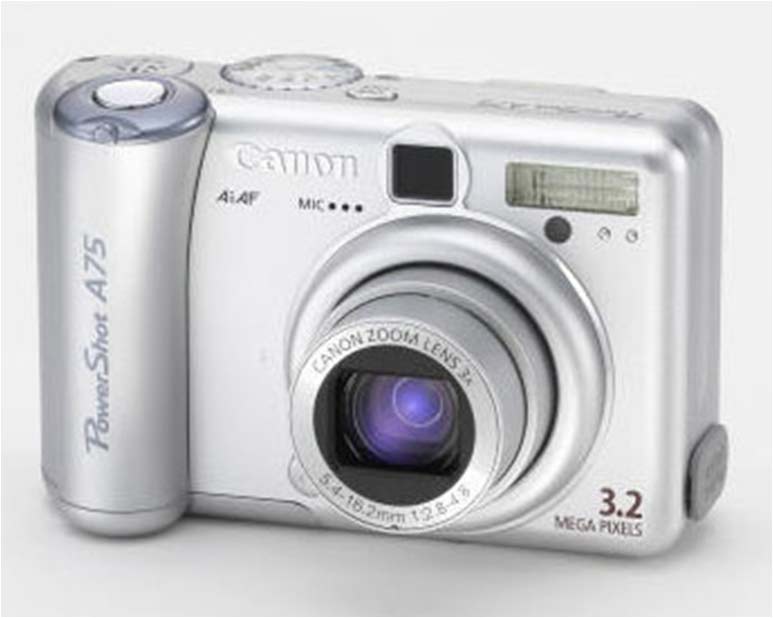
2000: Vanessa purchases her first digital camera
 2007: Vanessa photographs this fungus on a street in Kassal, Germany on a trip through Europe.
2007: Vanessa photographs this fungus on a street in Kassal, Germany on a trip through Europe.The End?
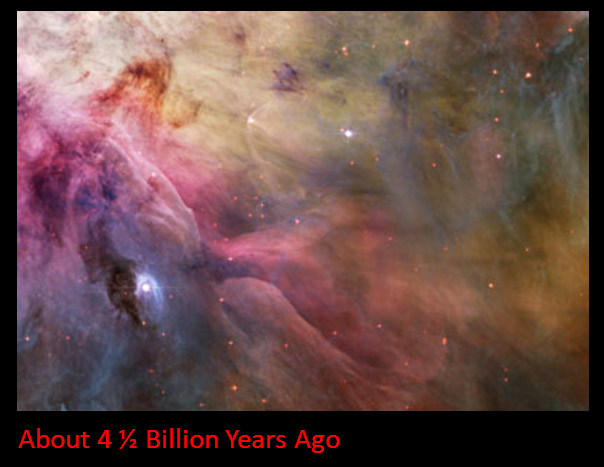 4 1/2 billion years ago, the solar system forms.
4 1/2 billion years ago, the solar system forms.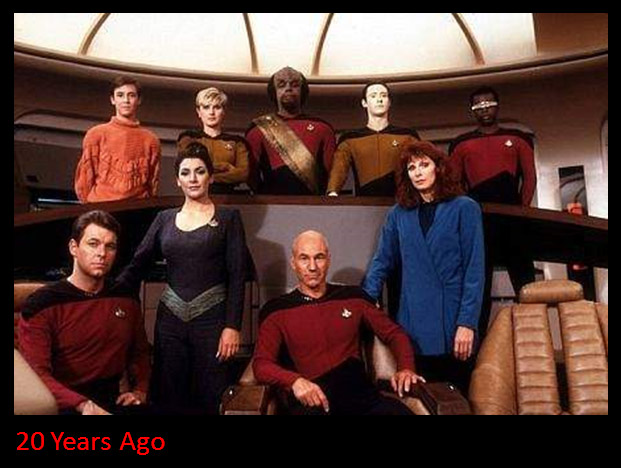 20 years ago, in 1987, Star Trek: The Next Generation premieres, syndicated by Paramount Pictures
20 years ago, in 1987, Star Trek: The Next Generation premieres, syndicated by Paramount Pictures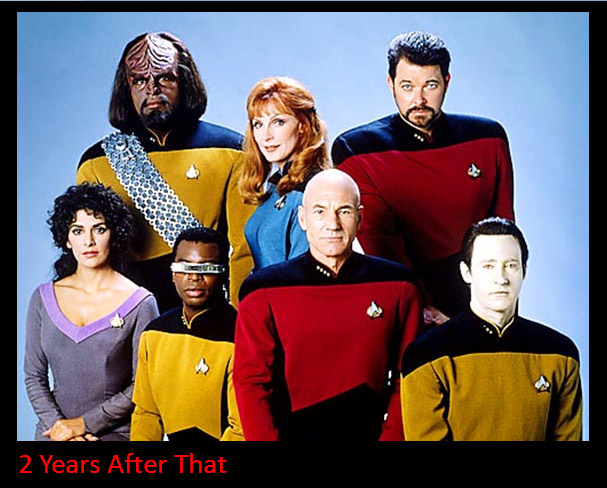
2 years later, Paramount revamps Star Trek: The Next Generation, providing a larger budget for new uniforms, graphics, and writing.
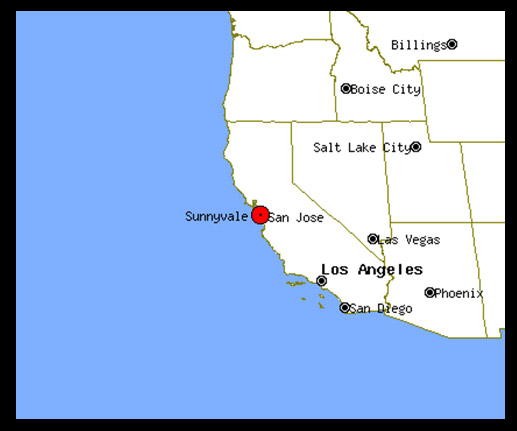 Growing up in the Silicon Valley during the 90s meant great opportunities, though a lack of focus.
Growing up in the Silicon Valley during the 90s meant great opportunities, though a lack of focus.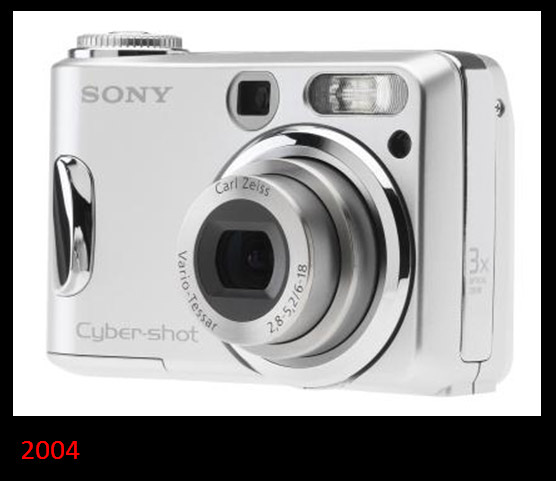 2004, first digital camera purchased.
2004, first digital camera purchased.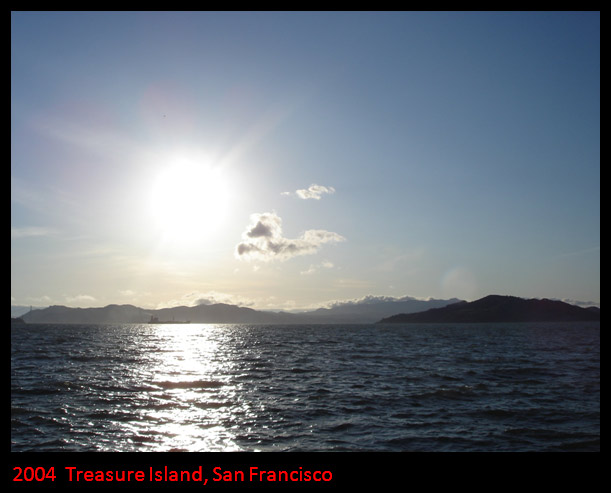 2004, first image taken.
2004, first image taken.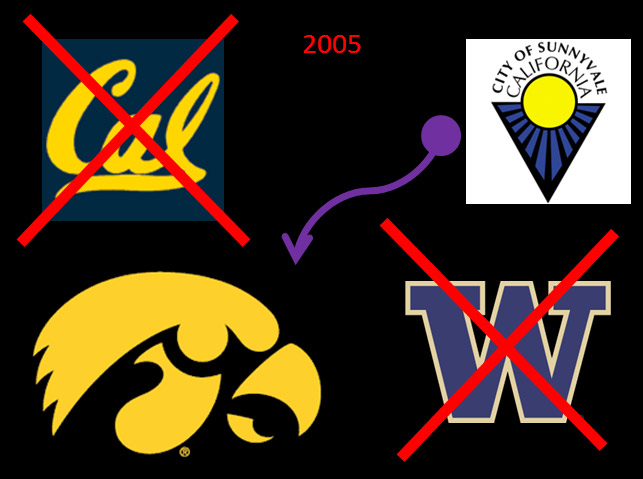 2005, scouting for professional development opportunities, including UC-Berkeley (proximity) and The University of Washington (brother's alma mater), The University of Iowa School of Art & Art History stood out for dedication to research and creative practice.
2005, scouting for professional development opportunities, including UC-Berkeley (proximity) and The University of Washington (brother's alma mater), The University of Iowa School of Art & Art History stood out for dedication to research and creative practice.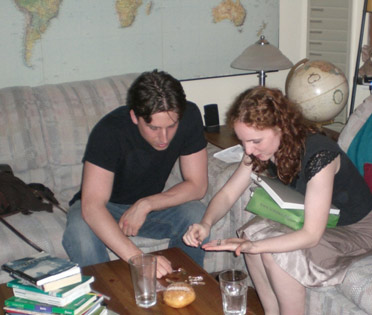 On a parallel trajectory to The University of Iowa in 2005 is Vanessa. Craig and Vanessa meet in Intermedia Workshop.
On a parallel trajectory to The University of Iowa in 2005 is Vanessa. Craig and Vanessa meet in Intermedia Workshop.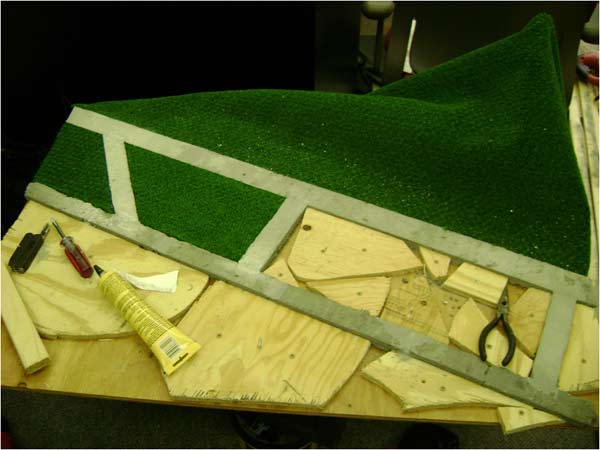 Forever changed, and with constant inspiration, and with productivity forever increased, Craig embarks on paths circling around trans-nationalism, including, sometimes, making fake airports.
Forever changed, and with constant inspiration, and with productivity forever increased, Craig embarks on paths circling around trans-nationalism, including, sometimes, making fake airports.
